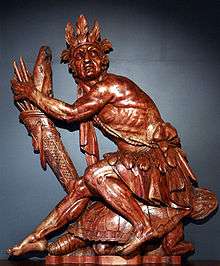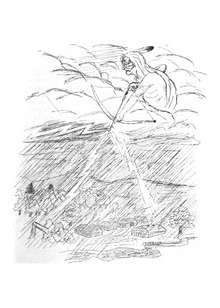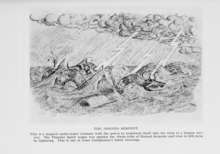Iroquois mythology
Much of the mythology of the Iroquois (a confederacy of originally Five, later Six Nations of Native Americans) has been preserved, including creation stories and some folktales. Recorded in wampum as recitations, written down later, the spellings of names differed as transliteration varies and spellings even in European languages were not entirely regularized. Different versions of some stories exist, reflecting different localities and different times. It is possible that the written versions were influenced by Christianity.

Each village had its own storyteller who was responsible for learning all the stories by heart. No stories were ever told during the summer months. Violations would be punished by the Jo-ga-oh, and if the violator ignored the warning he would suffer greater evils.[1]
Creation
This version of the creation story is taken from Converse[1]
The Earth was a thought in the mind of the ruler of a great island floating above the clouds. This ruler was called by various names, among them Ha-wen-ni-yu, meaning He who governs or The Ruler.[2] The island is a place of calm where all needs are provided and there is no pain or death. On this island grew a great apple[note 1] tree where the inhabitants held council. The Ruler said "let us make a new place where another people can grow. Under our council tree is a great sea of clouds which calls out for light." He ordered the council tree to be uprooted and he looked down into the depths. He had Ata-en-sic,[note 2] Sky Woman, look down. He heard the voice of the sea calling; he told Ata-en-sic, who was pregnant, to bring it life. He wrapped her in light and dropped her down through the hole.
All the birds and animals who lived in the great cloud sea were panicked. The Duck asked "where can it rest?" "Only the earth can hold it," replied the Beaver—the oeh-dah from the bottom of our great sea—"I will get some." The Beaver dove down, but never came up. Then the Duck tried, but its dead body floated to the surface. Many of the other birds and animals tried and failed. Finally, the Muskrat returned with some earth in his paws. "It's heavy", he said, "who can support it?" The Turtle volunteered, and the earth was placed on top of his shell. When the earth was ready the birds flew up and carried Ata-en-sic on their wings to the Turtle's back.
This is how Hah-nu-nah, the Turtle, came to be the earth bearer. When he moves the sea gets rough and the earth shakes.
The Do-yo-da-no
Once brought to at the surface the oeh-dah grew and became an island. Ata-en-sic heard two voices under her heart and knew her time had come. One voice was calm and quiet, but the other was loud and angry. These were the Do-yo-da-no, The Twins. The good twin, Hah-gweh-di-yu or Teharonhiakwako,[3] was born in the normal way. The evil twin, Hä-qweh-da-ět-gǎh or Sawiskera,[3] forced his way out from under his mother's arm, killing her.[note 3]
After the death of Sky Woman the island was shrouded in gloom. Hah-gweh-di-yu shaped the sky and created the sun from his mother's face saying "you shall rule here where your face will shine forever." Hä-qweh-da-ět-gǎh, however, set the great darkness in the west to drive down the sun. Hah-gweh-di-yu then took the Moon and Stars from his mother's breast, and placed them, his sisters, to guard the night sky. He gave his mother's body to the earth, the Great Mother from whom all life came.
Ga-gaah, the Crow, came from the sun land carrying a grain of corn in his ear. Hah-gweh-di-yu planted the corn above his mother's body, and it became the first grain. Ga-gaah hovers over the corn fields, guarding them from harm but also claiming his share.[1]
Hah-gweh-di-yu, corresponding to the Huron spirit Ioskeha, created the first people. He healed disease, defeated demons, and gave many of the Iroquois magical and ceremonial rituals. Another of his gifts was tobacco, which has been used as a central part of the Iroquois religion.
Hah-gweh-di-yu is aided by a number of assistant or subordinate spirits.
Hé-no

Hé-no is the spirit of thunder. He is represented as a man dressed as a warrior, wearing on his head a magic feather that makes him invulnerable to the attacks of Hah-gweh-di-yu. On his back he carries a basket filled with pieces of chert which he launches at evil spirits and witches. It is the responsibility of Hé-no to bring rain to nourish the crops. The Iroquois address Hé-no as Tisote (Grandfather).
He once lived in a cave under Niagara Falls. At that time a young girl living above the falls was engaged to marry a disagreeable old man. Rather than marry him she climbed into a canoe and headed down the river. The girl and the canoe were carried over the falls; the canoe was seen falling to destruction, but the girl disappeared. Hé-no and his two (nameless) assistants caught her in a blanket and brought her back to his cave. One of the assistants, taken with her beauty, married her.
Later Hé-no rescued her village from a huge serpent which was devastating it with disease. He lured the serpent to a spot on Buffalo Creek where he struck it with a thunderbolt. Fatally wounded, the serpent tried to escape to the safety of Lake Erie, but died before he could get away. His body floated downstream and stuck at the head of Niagara Falls, stretching nearly across the river and arching backward. The dammed up water broke the rocks, and the whole verge of the Falls along with the snake's body fell onto the rocks below. The break formed Horseshoe Falls, but in the process destroyed Hé-no's home.[2]
The De-oh-há-ko
The name means Our Life or Our Supporters. Often called "Three Sisters" they are the spirits of corn, beans, and squash. They have the form of beautiful maidens who are fond of each other and like to live near each other. This is an analogy to the plants which grow up together, sometimes from the same hill.[2]
One day while O-na-tah, the spirit of the corn, was wandering alone she was captured by Hä-qweh-da-ět-gǎh. Hä-qweh-da-ět-gǎh sent one of his monsters to devastate the fields, and the other sisters ran away. Hä-qweh-da-ět-gǎh held O-na-tah captive in darkness under the earth until a searching ray of sunl o the surface. Here she wept over the devastation of her fields and her abandonment by her two sisters. She vowed that she would never again leave her fields, and now she guards them alone, without the presence of her sisters.[1]
The Jo-ga-oh
The Jo-gä-oh, the "Little People", are invisible nature spirits, similar to the fairies of European myth. The Jo-ga-oh protect and guide all the natural world and protect the people from unseen hidden enemies.
There are three tribes of Jo-gä-oh.
The Ga-hon-ga inhabit the rivers and rocks. They live in rocky caves beside the streams and have great strength despite their small stature. They enjoy feats of strength, and have a fondness for inviting people to their habitations to compete in contests. They enjoy playing ball with rocks, tossing them high out of sight in the air, and so they are often called "Stone Throwers".
The Gan-da-yah protect and advise the fruits and grains. Their special gift is the strawberry plant; in the spring they loosen the earth so that the plant can grow. They turn the leaves toward the sun and guide the runners. The ripening of strawberries marks the spring festival. The Ho-non-di-ont, the "Company of Faith Keepers", hold dances of thanksgiving at night, with special thanks to the Jo-gä-oh for the strawberries.
Throughout the growing season the Gan-da-yah guard the crops against disease and other pests.
They sometimes visit the people in the form of birds: a robin for good news, an owl for a warning, a bat bringing news of an immanent life-and-death struggle.
The most minute harmless insect or worm may be the bearer of important "talk" from the "Little People" and is not destroyed for the "trail is broad enough for all".[1]
The Oh-do-was inhabit the shadowy places under the earth. In this underworld there are forests and animals, including a white buffalo. The Oh-do-was guard against poisonous snakes and creatures of death that try to escape from the underworld. From time to time the Oh-do-was emerge from the underworld at night into the world above. There they hold festivals and dance in rings around trees in the forest where the grass afterwards doesn't grow.[1]:101–107
Gǎ-oh and the winds
Gǎ-oh is the personification of the wind. A giant, he is an "instrumentality through whom the Great Spirit moves the elements".[2] His home is in the far northern sky.[note 4] Here he controls the four winds: north wind (Bear), west wind (Panther), east wind (Moose), and south wind (Fawn).[1]
The North Wind is personified by a bear spirit named Ya-o-gah. Ya-o-gah could destroy the world with his fiercely cold breath, but is kept in check by Gǎ-oh. Ne-o-ga, the fawn, is the south wind, "gentle, and kind as the sunbeam". The West Wind, the panther Da-jo-ji, "can climb the high mountains, and tear down the forests... carry the whirlwind on [his] back, and toss the great sea waves high in the air, and snarl at the tempests" O-yan-do-ne, the moose, is the East Wind, who blows his breath "to chill the young clouds as they float through the sky".
So-son-do-wah
So-son-do-wah was a great hunter, known for stalking a supernatural elk. He was captured by Dawn, a goddess who needed him as a watchman. He fell in love with Gendenwitha ("she who brings the day"; alternate spelling: Gendewitha), a human woman. He tried to woo her with a song. In spring, he sang as a bluebird, in summer as a blackbird and in autumn as a hawk, who then tried to take Gendenwitha with him to the sky. Dawn tied him to her doorpost. She changed Gendenwitha into the Morning Star, so the hunter could watch her all night but never be with her.
Flying Head
The Flying Head (moh:Kanontsistóntie's) is a monster in the form of a giant disembodied head as tall as a man. It is covered with thick hair, has long black wings and long sharp claws. It comes at night to the homes of widows and orphans, beats its wings on the walls of the houses, and issues terrifying cries in an unknown language. A few days after its visit death claims one of the family.[4] The Seneca name Dagwanoenyent means "whirlwind".
Djodi'kwado'

Djodi'kwado' was a horned serpent who inhabited the depths of rivers and lakes. He was capable of taking on the form of a man and seducing young women. He features prominently in the tales "The Horned Serpent Runs Away with a Young Wife who is Rescued by the Thunderer"[5]:218–222 and "Thunder Destroys Horned Snake".[6] In "The Great Serpent and the Young Wife" he appears as a helpful being, although his help proves less than useful. He was attacked and may have been killed by Hé-no.[5]:223–227
Tuscarora legend
Virginia surveyor William Byrd II, in his History of the Dividing Line Betwixt North Carolina and Virginia (1728), recorded a tradition of a former religious leader, which had been current among the Tuscarora tribe. They were an Iroquoian-speaking tribe historically settled in North Carolina that, because of warfare, migrated to join the rest of the Iroquois Confederacy in New York.
[H]owever, their God, being unwilling to root them out for their crimes, did them the honour to send a Messenger from Heaven to instruct them, and set Them a perfect Example of Integrity and kind Behavior towards one another. But this holy Person, with all his Eloquence and Sanctity of Life, was able to make very little Reformation amongst them. Some few Old Men did listen a little to his Wholesome Advice, but all the Young fellows were quite incorrigible. They not only Neglected his Precepts, but derided and Evil Entreated his Person. At last, taking upon him to reprove some Young Rakes of the Conechta Clan very sharply for their impiety, they were so provok'd at the Freedom of his Rebukes, that they tied him to a Tree, and shot him with Arrows through the Heart. But their God took instant vengeance on all who had a hand in that Monstrous Act, by Lightning from Heaven, & has ever since visited their Nation with a continued Train of Calamities, nor will he ever leave off punishing, and wasting their people, till he shall have blotted every living Soul of them out of the World.[7]
The Three Brothers Who Followed the Sun under the Sky's Rim
This is an Iroquois sun myth based on three brothers who tire of being on earth and decide to chase the sun and end up in the sky. Two of the three brothers succeed with the third succeeding in spirit only. The Sun Spirit remakes and tests the two brothers, who end up staying in the realm of the sky for many years. They miss their home and end up returning, only to find that many years have passed. With mostly everything they knew either changed or gone, they long to return to the realm of the sky, which happened when they were both struck by lightning as earthly perils could not harm them.[8]
See also
- The Great Peacemaker
- Seneca mythology
- Turtle Island (North America)
- Gaasyendietha
Notes
- Parker says "The central tree in the heaven world was the apple." The apple tree was introduced by European settlers. Elsewhere he suggests that the crab apple ("wild-apple") is meant.
- Parker says: "Ata’-en’sic ... is the Huron name for the first mother, and not that of the (confederated) Iroquois, The Senecas usually give this character no name other than Ea-gen’-tci, literally old woman or ancient bodied. This name is not a personal one, however. Mrs Converse has therefore substituted the Huronian personal name for the Iroquoian common name."
- Other versions of the story say that Ata-en-sic gave birth to a daughter. This daughter was impregnated by the wind, gave birth to the twins, and died, leaving her sons in the care of Ata-en-sic
- So Converse; Caswell says west.
References
- Converse, Harriet Maxwell (Ya-ie-wa-no); Parker, Arthur Caswell (Ga-wa-so-wa-neh) (December 15, 1908). "Myths and Legends of the New York State Iroquois". Education Department Bulletin. University of the State of New York: 10–11. Retrieved Nov 9, 2014.
- Morgan, Lewis Henry (1995). The League of the Iroquois. J G Press. pp. 141–174. ISBN 1-57215-124-2.
- Louellyn White (2015). Free to Be Mohawk: Indigenous Education at the Akwesasne Freedom School. University of Oklahoma Press. p. 29. ISBN 9780806153254.
- Canfield, William W. (1902). The Legends of the Iroquois: Told by "the Cornplanter". New York: A. Wessels Company. pp. 125–126. Retrieved Jan 27, 2016.
- Parker, Arthur C. (1923). Seneca Myths and Folk Takes. Buffalo, New York: Buffalo Historical Society. Retrieved Jan 2, 2020.
- "THUNDER DESTROYS HORNED SNAKE". Internet Sacred Text Archive. Retrieved Jan 2, 2020.
- William Byrd II, History of the Dividing Line, entry for Nov. 12, 1728.
- Parker, Arthur C. (1910-01-01). "Iroquois Sun Myths". The Journal of American Folklore. 23 (90): 473–478. doi:10.2307/534334. JSTOR 534334.
External links
- Parker, Arthur C (1923). Seneca Myths and Folk Tales. Buffalo, New York: Buffalo Historical Society. Retrieved May 26, 2015.